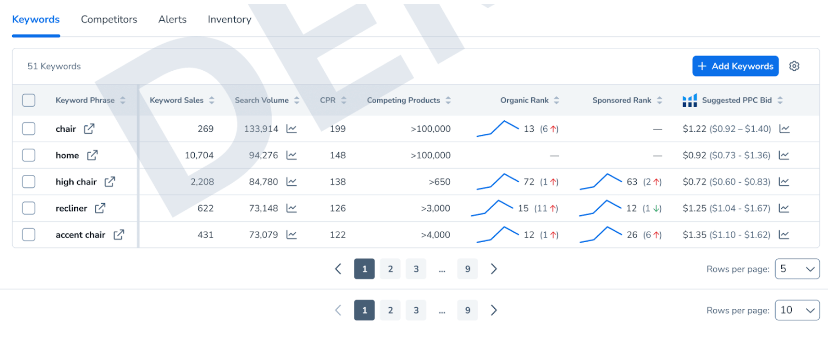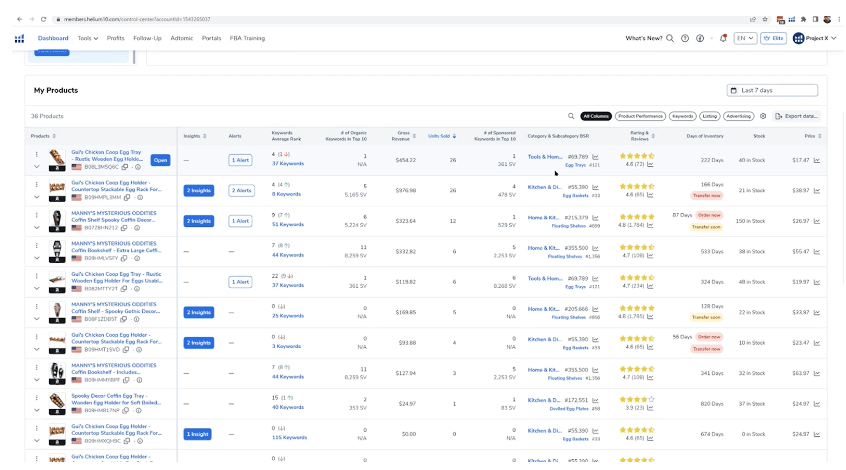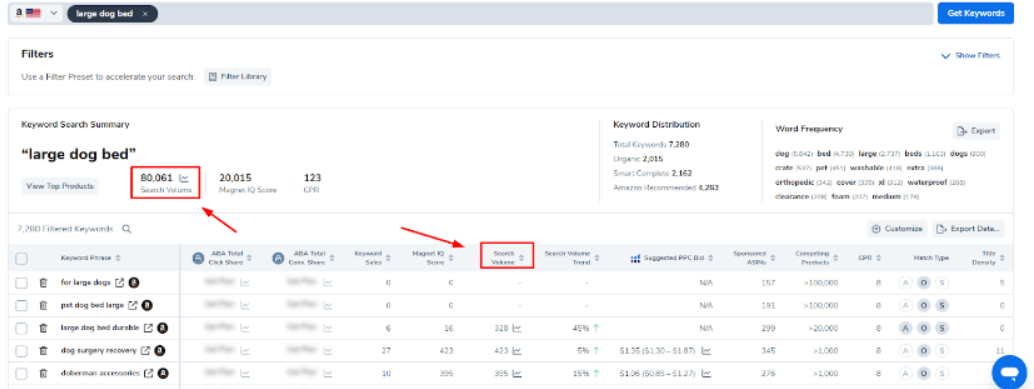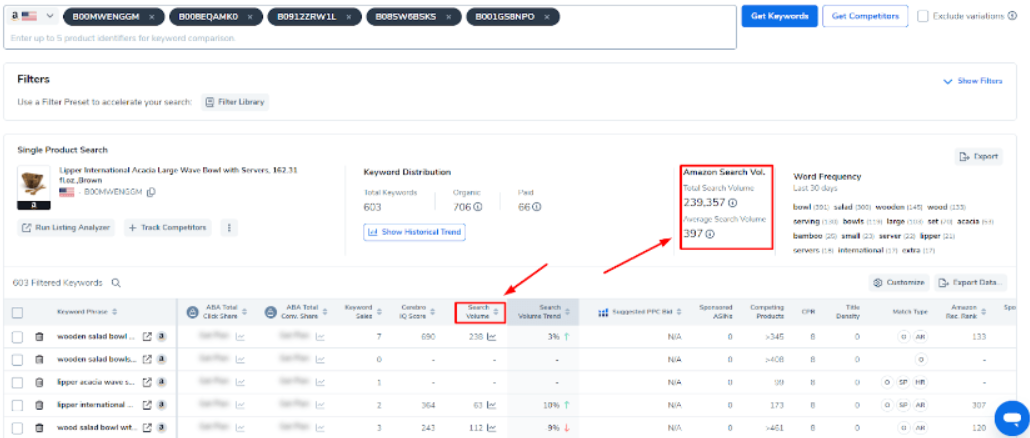Helium 10’s Search Volume tool gives sellers key insights into keyword popularity and market demand. By tracking the frequency with which terms are searched, this tool helps sellers identify trending products, optimize their listings, and enhance their visibility in Amazon search results.
Whether you’re launching a new product or refining your strategy, understanding keyword performance over time is crucial. In this article, we’ll explore how Helium 10 calculates search volume, how accurate it is, and why it matters for your business.
Let’s dive in!
Key Takeaways
- Helium 10 search volume shows the estimated monthly searches for keywords, products, and ASINs on Amazon.
- The search volume feature is available with the Starter plan ($39/month)
- It is calculated using algorithms based on actual Amazon data and machine learning.
- Search volume insights help sellers optimize listings, find opportunities, and boost sales.
What Is Helium 10 Search Volume?
Helium 10 search volume offers a strategic lens into the minds of Amazon shoppers. It estimates the monthly frequency with which customers search for a specific keyword, product name, or ASIN within Amazon.
Why this metric matters:
- Market demand insights: Validate overall interest within a niche before investing in a product. Does a consistent volume of searches for “vegan protein powder” indicate sufficient demand?
- Competitive analysis: Analyze a competitor’s product by assessing the search volume associated with its ASIN. This reveals their level of customer traffic, highlighting potential areas to optimize your listings.
- Informed estimates: While search volume naturally fluctuates, Helium 10 provides a reliable range to base decisions. This fosters calculated decisions rather than guesswork.
How it works: Helium 10’s estimates are not mere guesses. They utilize advanced algorithms that process real-time Amazon data, offering an informed prediction of shopper behavior. While not absolutely precise, these estimations remain extremely valuable for maximizing success on Amazon.
How Is Helium 10 Search Volume Calculated?
Helium 10 applies an advanced and versatile approach to provide reliable estimations:
- Real-Time Amazon Data Streaming: Helium 10 leverages connections to Amazon’s API, acquiring a continuous feed of current market data. This includes sales figures, customer search behaviors, and other relevant metrics that offer clues about search volume patterns.
- Machine Learning Refinement: Powerful machine learning models play a vital role. These models learn to identify complex patterns and correlations by analyzing massive volumes of historical Amazon data. This empowers them to refine search volume predictions, improving accuracy over time.
- Proprietary Algorithms: Helium 10 has developed specialized algorithms designed for search volume estimation. These formulas weigh a range of factors informed by live and historical Amazon data to produce comprehensive calculations.
Key Considerations –
- Search volume is an informed estimate due to market and shopper variability.
- Using real-time and historical data aligns estimations closely with Amazon’s tools, promoting reliability.
Helium 10 Search Volume Data Insights
Helium 10 search volume analysis empowers sellers to maximize sales by revealing actionable insights into the Amazon marketplace:

- Market Trends: Identify products experiencing surges or declines in popularity. This facilitates proactive sourcing decisions, capitalizing on emerging trends while avoiding saturation.
- Product Demand: Assess the potential of new product ideas by quantifying search interest. Helium 10 allows you to pinpoint untapped niches with high demand and assess the appeal of specific product features.
- Competitor Performance: Dissect competitor strategies by examining their top-performing keywords and estimated traffic sources. This information will help you refine your own SEO and advertising efforts.
- Product Seasonality: Understand the cyclical nature of certain products based on search volume data. Optimize inventory levels and strategically time marketing campaigns to maximize profits during peak demand periods.
- Organic Keywords: Uncover high-potential keywords with search volume and competition analysis. Prioritize keywords tailored to customer search habits, enabling improved organic search ranking and visibility.
Helium 10 search volume insights ultimately translate abstract market data into concrete, profit-focused strategic opportunities for Amazon sellers.
Why Is Helium 10 Search Volume Important For Amazon Sellers?
Helium 10 search volume serves as a pillar of success on Amazon. It unveils the keywords and products actively sought after by customers, offering invaluable guidance for strategic optimization. This data helps sellers with the potential to the following aspects.
- Focus on Profitability: Identifying keywords and products with high search volume and manageable competition helps prioritize resources and maximize return on investment. It removes the guesswork of deciding where to focus your efforts.
- Listing Optimization: Search volume data reveals the precise language customers use. This informs crafting titles, descriptions, and backend keywords that resonate with Amazon’s search algorithms and shoppers.
- Strategic SEO: Search volume metrics pinpoint keywords likely to drive organic traffic. By carefully integrating these keywords, sellers increase visibility without solely relying on paid advertising.
- Efficient PPC Spend: Optimize bids and budgets based on keyword search volume. Prioritize spending on high-traffic terms to maximize exposure while strategically targeting less competitive keywords.
Using Helium 10’s search data helps make informed decisions. These data-driven optimizations boost traffic, conversions, and sales on Amazon.
How Can Helium 10 Search Volume Be Used To Improve Product Listings And PPC Campaigns?
Helium 10 search volume is not just abstract data; it offers powerful, granular optimizations:

Product Listing Optimization
- Keyword Selection: Analyze search volume to strike the optimal balance. Prioritize the terms shoppers use in titles and descriptions and explore long-tail keywords for less competitive niches. Backend search terms become even more strategic.
- Customer-Centric Language: High-volume keywords reveal what customers search for and how they phrase it. This improves bullet points, making them instantly relatable and enticing to your audience.
PPC Campaign Refinement
- Ad Copy Precision: Search volume data informs tailored ad copy reflecting customer search intent. This improves click-through rates and minimizes wasted impressions on irrelevant keywords.
- Strategic Bidding: Balance aggressive bids for high-volume, high-competition keywords against smarter spending. Identify opportunities with less rivalry and target the budget where ROI is most likely.
- Organic Expansion: Explore high-volume keywords with lower competition as focus areas for SEO efforts. Climbing organically reduces dependency on PPC spending in the long term.
Beyond Listings & Ads
- Product Development: Search volume offers true market validation. Uncover unmet customer needs within a broader niche (e.g., demand for an uncommon variation of a popular product), driving new product creation.
How Do I See the Search Volume History in Cerebro and Magnet?
Magnet and Cerebro are both keyword research tools on Helium 10. Both tools show the exact metrics for the keywords you get after using the filters, including the search volume.
The only difference between both tools is their research process. Magnet shows keywords based on a seed keyword related to your listing or category.
This is particularly helpful for sellers when creating a list of opportunity keywords for their listing optimization and SEO. However, choosing these keywords doesn’t guarantee success or a high ranking in the search results unless you use advanced filters to find a precise list.

On the other hand, Cerebro shows keywords for selected ASINs. Sellers can copy the ASINs of their competitors and paste them into the search box to get the exact keywords they use in their listing and PPC campaigns.

With Cerebro, you can see the total and average search volume of keywords, along with the exact search volume of listed keywords. Since all of them are accurately distributed, you will know which one to target for search terms and PPC campaigns.
Here’s a quick tutorial from Helium 10 you can check to find the search volume metric on Cerebro: How to Check the Search Volume History of an Amazon Keyword – Cerebro Pro Training
Final Words: Helium 10 Provides Accurate Search Volumes!
Helium 10’s search volume data shows customer demand for keywords and products. Both new and existing Amazon sellers can use this metric to optimize their listings for relevancy and find profitable products to sell on the platform.
Having accurate search volume data can give you a competitive advantage over your competitors. Whether searching for a niche or planning to launch a new product in a specific category, tools like Magnet, Cerebro, Trendster, and Black Box will give you exact search volume data for these purposes.
The search volume metric is available with Helium 10 free plan tools. So sign up for free and find out all about this metric by yourself.